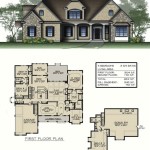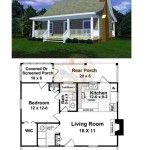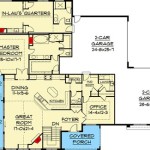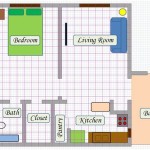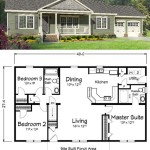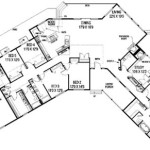Floor Plans For Existing Homes: A Comprehensive Guide
Floor plans are fundamental to understanding the layout and flow of a home. They serve as visual representations of a building's structure, showcasing room dimensions, door and window placements, and the relationships between different spaces. While often associated with new construction, floor plans are equally valuable for existing homes. Accurately documenting an existing home's floor plan offers a range of benefits, from facilitating renovations and interior design to aiding in property valuation and sales.
This article provides a comprehensive guide to floor plans for existing homes, covering the various methods for creating them, the types of information they convey, and the practical applications they serve. It will delve into the importance of accurate measurements, the software and tools available, and the potential challenges that may arise during the process.
Methods for Creating Floor Plans of Existing Homes
Several methods can be employed to create floor plans of existing homes, each with its own level of precision, cost, and time commitment. The choice of method depends on the intended use of the floor plan, the required level of detail, and the available budget.
Manual Measurement and Drafting: This involves manually measuring the dimensions of each room and feature within the home using a measuring tape or laser distance measurer. The measurements are then carefully transferred onto graph paper or drafting software and meticulously drawn to scale. This method requires a degree of technical skill and patience. It is best suited for simple layouts and when a high degree of accuracy is not critical. The manual process can take a long time and it's easier to make mistakes. This method is cost-effective as it only requires basic measuring tools and graph paper or free drafting software.
Potential challenges with manual measurement and drafting include dealing with irregular shapes, alcoves, and complex architectural details. Consistently maintaining accuracy throughout the entire drawing process is critical to avoid compounding errors. This method can become cumbersome for larger or more complex properties.
Laser Distance Measurer and Sketching: A laser distance measurer significantly improves the speed and accuracy of the measurement process compared to traditional measuring tapes. The laser device instantly provides precise measurements of distances, which can be recorded and then used to create a sketch of the floor plan. The sketch can then be transferred to drafting software for refinement and creation of a professional-looking floor plan.
This method balances accuracy with efficiency. The laser distance measurer reduces the potential for human error in measuring distances. Sketching simplifies the process of capturing the overall layout and room relationships, making it a more manageable approach than completely manual drafting. This method is suitable for both simple and moderately complex properties. The initial investment in a laser distance measurer is required, but the time savings and improved accuracy often justify the expense.
Digital Floor Plan Apps: Numerous smartphone and tablet applications are available for creating floor plans. These apps typically use the device's camera and augmented reality (AR) technology to estimate room dimensions and create a basic floor plan. Some apps require the user to physically walk through the space, while others use image recognition algorithms to generate the plan from a series of photographs.
Digital floor plan apps offer convenience and speed. They are particularly useful for generating quick floor plans for personal use or preliminary design concepts. However, the accuracy of these apps can vary significantly depending on the quality of the device's camera, lighting conditions, and the complexity of the space. The floor plans generated by these apps may require further refinement and verification using other measurement methods.
Professional Floor Plan Services: Engaging a professional floor plan service provides the most accurate and detailed results. These services typically employ skilled technicians who use specialized equipment, such as laser scanners and 3D modeling software, to create precise floor plans. They can also incorporate additional features such as elevations, furniture layouts, and virtual tours.
Professional floor plan services offer the highest level of accuracy and comprehensive documentation. They are the ideal choice for projects requiring detailed floor plans for architectural design, construction documentation, or marketing purposes. However, these services are the most expensive option. The cost depends on the size and complexity of the property, the level of detail required, and the specific services provided.
Key Elements of a Floor Plan
A comprehensive floor plan provides a wealth of information about the layout and features of a home. Several key elements are essential for creating an effective and informative floor plan.
Accurate Dimensions: The foundation of any floor plan is accurate dimensions. Every room, hallway, doorway, and window must be measured precisely and represented to scale on the drawing. Incorrect dimensions can lead to significant problems during renovation or design projects.
Dimensions should include the overall length and width of each room, as well as the height of ceilings. The placement and size of doors and windows are also crucial. All measurements should be clearly labeled on the floor plan, typically using standard units such as feet and inches or meters and centimeters. It is paramount that the same unit of measure is used throughout the entire plan. The plan needs to specify which unit of measurement is being used.
Wall Thickness and Construction: The thickness of walls, both interior and exterior, should be accurately represented on the floor plan. Different wall types, such as load-bearing walls, partition walls, and exterior walls, should be identified. This information is essential for structural analysis and renovation planning.
Wall construction details, such as the materials used (e.g., drywall, brick, concrete), should also be noted. This information can be helpful for understanding the thermal and acoustic properties of the walls. Standard symbols are often used to indicate different wall thicknesses and materials. A legend should be included to explain the symbols used.
Door and Window Placement: The location, size, and swing direction of doors and windows are critical elements of a floor plan. Doors should be represented with a curved line indicating the direction of the swing. Windows should be clearly identified with their dimensions and type (e.g., casement, double-hung, sliding).
The placement of doors and windows affects the flow of traffic within the home and the amount of natural light that enters each room. Accurately representing these features on the floor plan is essential for effective space planning and design.
Fixed Fixtures and Appliances: The location of fixed fixtures and appliances, such as sinks, toilets, bathtubs, stoves, refrigerators, and water heaters, should be indicated on the floor plan. These items are often represented using standard symbols. This information is essential for planning renovations, particularly plumbing and electrical work.
The floor plan should also indicate the location of electrical outlets, switches, and light fixtures. This information is crucial for understanding the electrical system of the home and planning any electrical modifications.
Staircases and Ramps: Staircases and ramps are important architectural features that should be accurately represented on the floor plan. The direction of travel, the number of steps, and the width of the staircase should be clearly indicated. Ramps should be shown with their slope and length. Accurately depicting staircases and ramps is essential for accessibility planning and safety considerations.
Other Structural Elements: Additional structural elements, such as columns, beams, and fireplaces, should also be included on the floor plan. These features can significantly impact the layout and design of the home. Their location and dimensions should be accurately represented.
Applications of Floor Plans for Existing Homes
Floor plans for existing homes serve a wide range of practical applications, benefiting homeowners, real estate professionals, architects, and interior designers.
Renovations and Remodeling: Floor plans are essential for planning and executing renovations and remodeling projects. They provide a clear understanding of the existing layout, allowing designers and contractors to develop accurate plans and estimates. Floor plans are used to identify potential structural issues, plan for new plumbing and electrical systems, and visualize the proposed changes.
Interior Design: Floor plans are invaluable tools for interior designers. They enable them to experiment with different furniture layouts, plan for optimal space utilization, and visualize the overall aesthetic of the home. Floor plans help designers ensure that furniture fits comfortably within each room and that the flow of traffic is efficient.
Real Estate Sales and Marketing: Floor plans are becoming increasingly common in real estate listings. They provide potential buyers with a clear understanding of the layout and dimensions of the property, allowing them to visualize themselves living in the space. Floor plans can significantly enhance the marketing of a property and attract more interested buyers.
Property Valuation: Floor plans can be used to calculate the square footage of a home, which is a key factor in determining its value. Accurate floor plans ensure that the square footage is calculated correctly and that the property is valued appropriately.
Insurance Documentation: In the event of a fire, flood, or other disaster, floor plans can be used to document the contents of a home for insurance purposes. This can help homeowners recover their losses more quickly and efficiently.
Accessibility Planning: Floor plans are essential for assessing the accessibility of a home for individuals with disabilities. They can be used to identify potential barriers, such as narrow doorways, steep stairs, and limited turning space. Floor plans can then be used to develop plans for making the home more accessible.
Permitting and Approvals: Many jurisdictions require floor plans as part of the building permit application process. Accurate floor plans ensure that the proposed construction complies with local building codes and regulations.
In summary, accurate and detailed floor plans for existing homes are an invaluable resource for numerous applications. They facilitate renovations, enhance interior design, aid in real estate transactions, assist with property valuation, support insurance claims, improve accessibility, and streamline the permitting process.

Home Addition Plan 6232

House Plans How To Design Your Home Plan

House Plans How To Design Your Home Plan

Great Room Addition Plan Post And Beam Barn Style Homes Plans Home Bedroom

Add A Floor Convert Single Story Houses Home Addition Plans Two House Bedroom

House Plans How To Design Your Home Plan

House Plans How To Design Your Home Plan

Interior Design Floor Plan Before After Reed

House Plans How To Design Your Home Plan

Where You Can Buy House Plans Live Home 3d

